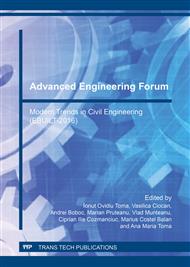p.272
p.280
p.286
p.294
p.301
p.309
p.319
p.327
p.335
Studies Regarding the Shear Correction Factor in the Mindlin Plate Theory for Sandwich Plates
Abstract:
The displacement field from the first-order shear deformation plate theory (FSDT) extents the cinematic aspect of the classical theory of laminated plates (CLPT), including a transverse shear deformation, considered constant on the plate thickness. In order to correct this aspect, in FSDT (named also the Mindlin plate theory) a coefficient Ks was inserted, named shear correction factor, used as a multiplier in the shear stiffness equation of the plate. In this paper are presented the most popular methods for determination of the shear correction factor, identifying the differences between them. To emphasize the influence of the shear correction factor on the stress response, a numerical parametric study was done on some sandwich plates filled with polyurethane foam. The processing of the obtained results allow drawing some conclusions useful in the designing of this type of sandwich plates.
Info:
Periodical:
Pages:
301-308
Citation:
Online since:
March 2017
Authors:
Price:
Сopyright:
© 2017 Trans Tech Publications Ltd. All Rights Reserved
Share:
Citation:


